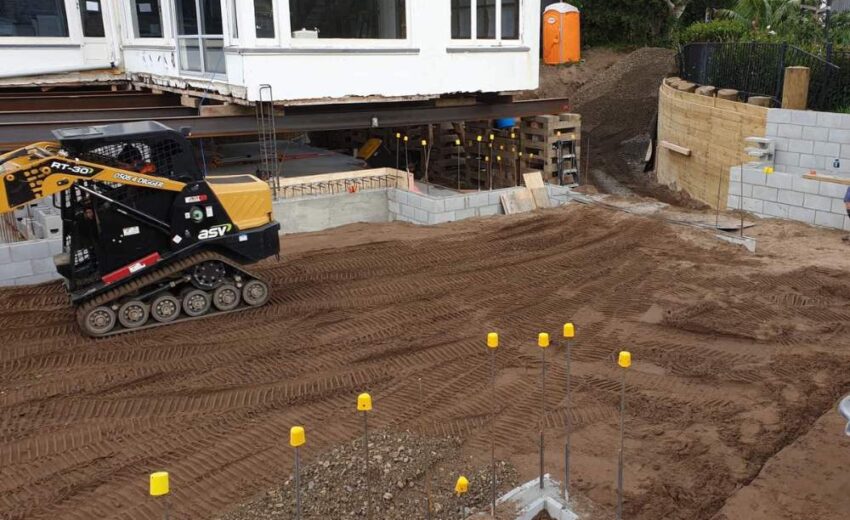
Site preparation is the first and one of the most critical stages in the construction process. Proper site preparation ensures that the construction project proceeds smoothly and that the structure built on the site is safe and durable.
This article will guide you through the essential steps involved in preparing a site for construction, incorporating relevant New South Wales (NSW) standards from the National Construction Code (NCC) 2019 Volume Two Amendment 1, specifically Part 3.1 Site Preparation and Part 3.1.1 Earthworks, as well as guidelines on earthworks for commercial and residential developments from AS 3798-2007.

1. Initial Site Assessment
Site Visit and Inspection
Before any work begins, a thorough site visit and inspection are essential. This includes:
- Topographical Survey: Understanding the site’s topography helps in planning the layout and design. It includes mapping out the terrain, slopes, and elevations
- Soil Testing: Conducting geotechnical investigations to determine soil composition, strength, and stability. This information is crucial for foundation design and ensuring the structure’s stability
- Environmental Impact Assessment: Assessing potential environmental impacts and identifying any protected areas, water bodies, or vegetation that need to be preserved.
Reviewing Legal Requirements:
- Zoning Laws: Ensure that the proposed construction is in compliance with local zoning regulations.
- Permits and Approvals: Obtain necessary permits and approvals from local authorities before commencing any work. This includes building permits, environmental clearances, and utility permissions.
- Compliance with NCC Standards: Ensure that all site preparation and earthworks comply with the NCC 2019 Volume Two Amendment 1, particularly Part 3.1.1 Earthworks, which covers requirements for excavation, filling, and compaction.
- Adhering to AS 3798-2007: Follow the guidelines on earthworks for commercial and residential developments, which provide standards for site investigations, field testing, and documentation.
2. Site Clearing
Removal of Vegetation and Debris
- Clearing Trees and Shrubs: Remove all vegetation, including trees, shrubs, and undergrowth. This may require specialized equipment like bulldozers and chainsaws.
- Debris Removal: Clear any debris, old structures, or materials left on the site. Proper disposal of this waste is essential to comply with environmental regulations.
Grading and Levelling
- Earthmoving: Use excavators, bulldozers, and graders to move soil and level the site. This process helps create a stable base for construction.
- Slope Stabilization: If the site has significant slopes, take measures to stabilize them. This may include terracing, retaining walls, or soil nailing.
3. Utility Location and Protection
Identifying Existing Utilities:
- Utility Mapping: Identify and map out existing underground utilities, such as water, gas, electricity, and sewer lines. This helps prevent accidental damage during excavation.
- Coordination with Utility Providers: Work with utility providers to mark the exact locations of their services and understand any special requirements for working near them.
Implementing Protective Measures
- Non-Destructive Digging: Use techniques like hydro-vacuum excavation to safely expose utilities without damaging them.
- Installing Protective Barriers: Erect barriers or protective covers around sensitive utilities to prevent damage during construction.

4. Excavation and Earthworks
Bulk Excavation
- Excavation Planning: Plan the excavation process carefully, considering factors like soil type, weather conditions, and the depth of excavation.
- Equipment Use: Employ heavy machinery like excavators, backhoes, and dump trucks for efficient and safe excavation.
Foundation Preparation
- Trench Excavation: Excavate trenches for foundations, ensuring they are at the correct depth and width as per engineering specifications.
- Compaction: Compact the soil at the bottom of the trenches to provide a solid base for the foundation. Use compactors to increase soil density and stability.
Compliance with AS 3798-2007
- Testing and Documentation: Conduct field density tests as per AS 3798-2007 guidelines to ensure proper compaction and record all findings for compliance.
- Quality Control: Implement quality control measures to maintain standards during earthworks, including regular site inspections and testing.
5. Drainage and Erosion Control
Installing Drainage Systems
- Surface Drainage: Install surface drainage systems like swales, ditches, and culverts to manage rainwater and prevent waterlogging.
- Subsurface Drainage: Implement subsurface drainage solutions like French drains or perforated pipes to manage groundwater and protect the foundation.
Erosion Control Measures:
- Silt Fences and Erosion Blankets: Use silt fences, erosion control blankets, and other measures to prevent soil erosion and sediment runoff.
- Vegetative Stabilization: Plant grass or other vegetation on slopes and disturbed areas to stabilize the soil and reduce erosion.
6. Sub-Base and Base Layer Installation
Sub-Base Preparation
- Material Selection: Choose appropriate sub-base materials, such as crushed stone or gravel, which provide a stable foundation for the base layer.
- Adding the Base Layer: Place the base layer material, typically asphalt or concrete, over the compacted sub-base.
Base Layer Construction
- Levelling and Compaction: Level and compact the base layer to ensure a smooth and stable surface, ready for the final construction activities.
- Spreading and Compaction: Spread the sub-base material evenly across the site and compact it using rollers to achieve the desired density and stability.
7. Final Preparations
Utility Installation
- Laying Utility Lines: Install utility lines for water, gas, electricity, and sewerage according to the construction plans.
- Connecting Services: Ensure that all utility services are connected and tested before proceeding with further construction.
Final Site Inspection:
- Quality Checks: Conduct a final inspection to ensure that all site preparation activities meet the required standards and specifications.
- Approval from Authorities: Obtain final approvals from local authorities, ensuring that all legal and regulatory requirements have been met.

Conclusion
Proper site preparation is the foundation of any successful construction project. By following these steps and ensuring thorough planning, assessment, and execution, you can create a stable and safe site ready for construction. Investing time and resources in meticulous site preparation helps avoid costly delays and issues during the construction phase, ultimately leading to a successful and durable build.
Remember, the key to effective site preparation lies in attention to detail, compliance with regulations, and the use of appropriate machinery and techniques. Safe Digging Services exemplifies these principles, ensuring every project starts on solid ground. For more detailed standards and guidelines, refer to the NCC 2019 Volume Two Amendment 1, particularly Part 3.1 Site Preparation and Part 3.1.1 Earthworks, and the AS 3798-2007 guidelines on earthworks for commercial and residential developments.



